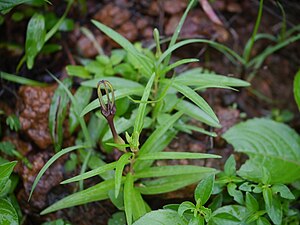Ceropegia concanensis
| Ceropegia concanensis | ||||||||||||
|---|---|---|---|---|---|---|---|---|---|---|---|---|

Ceropegia concanensis |
||||||||||||
| Systematics | ||||||||||||
|
||||||||||||
| Scientific name | ||||||||||||
| Ceropegia concanensis | ||||||||||||
| Kambale , Chandore & SRYadav |
Ceropegia concanensis is a species of plant from the subfamily of the asclepiadoideae (Asclepiadoideae). The species occurs only in two very small areas in the districts of Sindhudurg and Kolhapur in the Indian state of Maharashtra . The specific epithet is derived from the Konkan find region.
features
Vegetative characteristics
Ceropegia concanensis is a perennial , upright plant with a bulbous rhizome. The flattened-rounded, egg-shaped to round tubers reach a diameter of 2 to 5 cm. Only a single shoot grows out of the tuber, freshly driven out more or less finely hairy; the shoot becomes smooth with age. It is unbranched and up to 30 cm high. It reaches 1 to 2 mm in diameter and is green or dark purple in color. The pairs of leaves are arranged crosswise. The leaves are subsessile. The linearly shaped, pointed leaf blade is 3.2 to 6.4 cm long and 0.8 to 1.4 cm wide. They are hairy on the upper side and glabrous on the underside. The edges are covered with cilia, the central rib stands out clearly.
Inflorescence and flowers
The flowers are solitary and arise in the leaf axils, but can also attach outside the leaf axils. Are hermaphroditic , zygomorphic and five-fold with a double flower envelope. The peduncle is 3 to 5 mm long, slender and hairy downy. The slender, also downy hairy flower stalks are 5 to 6 mm long and 1 to 1.5 mm thick. The awl bracts stand individually, are 2 to 3 millimeters long and 0.2 to 0.4 mm wide. They are hairy along the edges. The sepals are linear (4 to 7 mm long and 0.3 to 0.6 mm wide) and pointed at the outer end. They are hairy along the midrib. The five petals are fused to a tube-like corolla, except for the free tips of the petals. The outside bare corolla is 4 to 5.4 cm long (high) and mostly slightly curved. The corolla tube accounts for 3 to 3.5 cm, with a diameter of 2 to 2.5 mm. It is inflated at the base ("crown bowl") and light yellowish green. Above the crown bowl, the corolla tube is purple on the outside, and in the upper half with darker purple longitudinal lines. The petal lobes are 1.2 to 1.6 cm long, linear and bent back along the longitudinal axis. The tips of the tips are fused together. They form an obovate, cage-like structure. They are yellowish-green to reddish yellow in color and hairy on the edges. The base of the tips is speckled with large dark purple spots on the inside. The secondary crown is 4 to 5 mm long (high). The interstaminal (or outer), cup-shaped secondary crown is fused at the base. The five corolla leaf lobes, deeply incised in the middle, are drawn out at the ends to two points and sparsely hairy on the edges. The staminale (or inner) secondary crown has five upright lobes, splaying out at the end, which are purple in the lower half and yellowish in the upper half. The pollinia are attached to the brown pollen carriers by short elastic appendages (caudicles). The pollinarium measures 0.3 × 0.2 mm.
Fruits and seeds
The paired follicles are spindle-shaped, elongated, up to 8 cm long, with a diameter of only 3 millimeters and smooth. The elongated, egg-shaped, brown seeds measure 4 × 2 mm. The silky white head of hair is approx. 1 cm long.
Similar species
Ceropegia concanensis is similar to Ceropegia attenuata , which is also native to the Western Ghats, but has a much larger distribution area (from Mumbai (Maharashtra) in the north to Kumta ( Karnataka ) in the south). The corolla lobes are shorter in C. concanensis than the corolla tube (in C. attenuata about the same length), the corolla tube swells quite abruptly towards the base (or crown cup) (in C. attenuata the increase in diameter is gradual and the interstaminal corona is gradual is only sparsely hairy in C. concanensis , densely hairy in C. attenuata ).
Geographical distribution and ecology
The species is spread over two small areas of only approx. 5 km² each around the places Vengurla (15 ° 52.507 'N, 73 ° 37.229'E), 82 m, Devgad, 50 m, Sindhudurg district and Tillari (15 ° 47.465 'N, 74 ° 10.778'E), 742 m, Kolhapur District, in the Indian state of Maharashtra .
The species grows in the open grasslands of lateritic plateaus from about 50 m (Devgad) to 750 m (Tillari) above sea level. It is present at the named locations with Dimeria spp., Eriocaulon spp., Euphorbia antiquorum L., Glyphochloa spp., Hedyotis pumila L. f., Impatiens tomentosa Heyne, Leucas aspera (Willd.) Link, Rhamphicarpa longiflora Wight ex Benth., Striga gesnerioides (Willd.) Vatke u. a. socialized with other species. In the natural habitat, the flowers appear in July / August, the fruits in September / October.
Human use and exposure
The tubers are edible and are also collected by the local population. In total, only about 50 plants were found in the two small discovery areas (each only about 5 km² in size). According to the IUCN criteria, the species falls into the critically endangered category. The flora (and fauna) of the grasslands of the lateritic plateaus around Vengurla and Devgad in the Sindhudurg district and around Tillari in the Kolhapur district is primarily endangered by the conversion of these habitats into mango plantations.
literature
- Sharad Suresh Kambale, Arun Nivrutti Chandore, Shrirang Ramchandra Yadav: Ceropegia concanensis, a new species (Apocynaceae: Ceropegieae) from Western Ghats, India. In: Kew Bulletin , Volume 67, 2012, 843-848 ( doi : 10.1007 / s12225-012-9406-0 )
